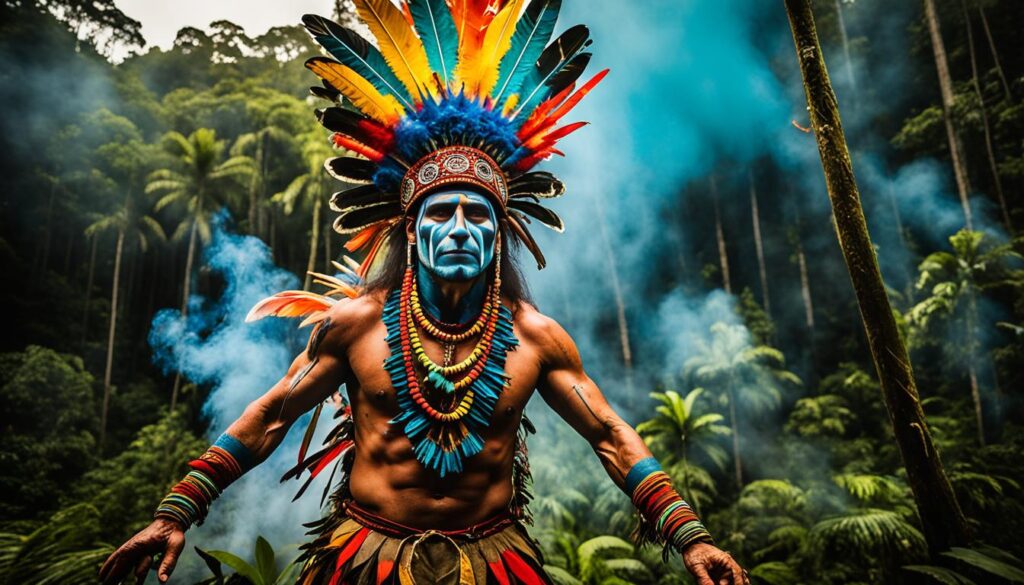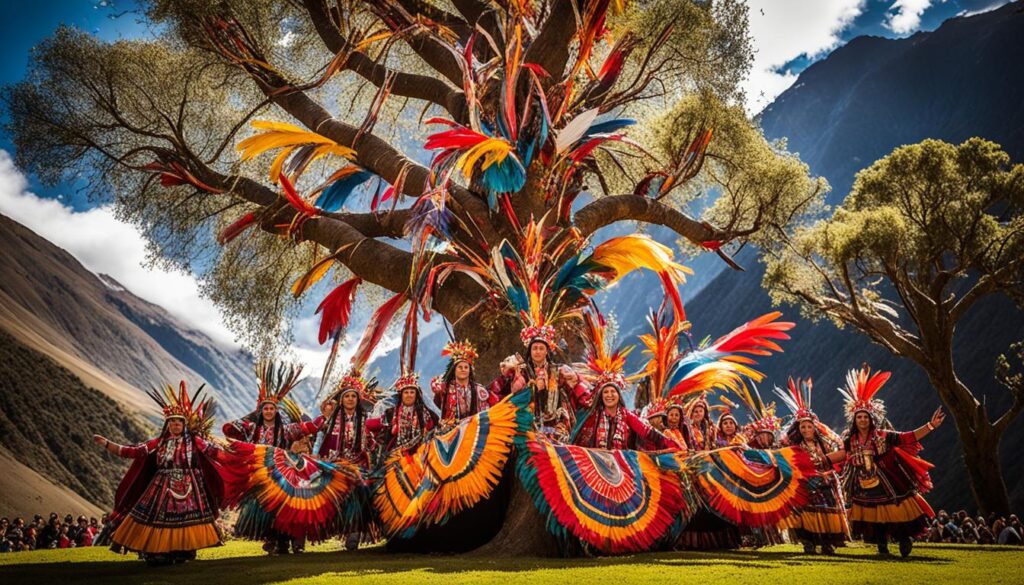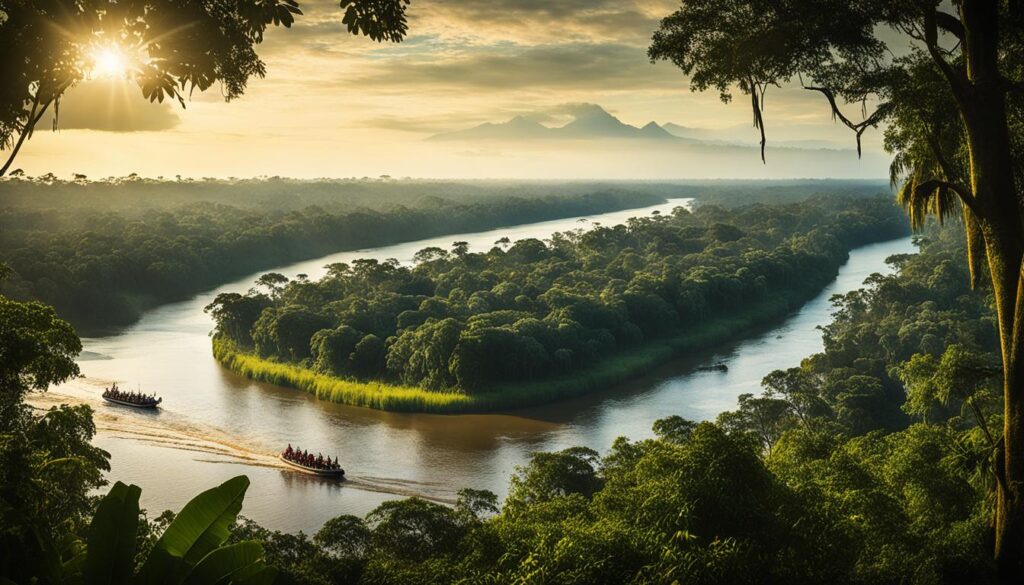The Amazon Rainforest is a place of wonder. Yet, few know how its name came to be. The name sprang from myth and conquest, tied to stories of warrior women. These women were like those in Greek myths called Amazons. In the 1540s, explorer Francisco de Orellana journeyed through its jungles. He chose the name inspired by tales of fierce warrior women he had heard.
The story behind the Amazon Rainforest’s name is fascinating. It reflects European explorers’ first meetings and the forest’s immense beauty. This name carries stories of indigenous tribes met by these adventurers. It’s not just about trees and animals. The name captures human creativity, how we see the world, and its mysteries.
Learning the Amazon Rainforest’s name history reveals more than discoveries. It connects us to legends and truths that define this vast rainforest. Through stories and records from the past, we understand its name better. This journey through time shows us the narrative’s power, reaching us today.
Key Takeaways
- The original naming of the Amazon Rainforest was influenced by mythological narratives dating back to the Spanish Conquistadors.
- Francisco de Orellana played a pivotal role in the etymology of the Amazon Rainforest based on his encounters with indigenous tribes.
- Warrior women, akin to the mythical Amazons, stood at the center of the Amazon Rainforest name origin story.
- The name carries a complex blend of history, legend, and linguistic evolution that still captivates researchers and historians.
- Understanding the history of the Amazon Rainforest name offers valuable insights into the early cross-cultural exchanges and perceptions.
The Immense Diversity and Geographic Marvel of the Amazon
The Amazon Rainforest is vast and colorful, like nature’s own art. It covers about 5,500,000 square kilometers. It’s not just a home for countless plants and animals but also a place of wonder, which makes it key in talking about Amazon Rainforest geography and ecosystems. It stretches across nine different countries, with each area having its own unique life and survival tales.
The Amazon’s Vast Ecosystems and Rich Cultures
The Amazon is full of different landscapes, from tall mountains to big savannahs and wet swamps. The Amazon Rainforest ecosystems are home to around 390 billion trees from 16,000 species. But it’s not just about trees and animals. Over 350 ethnic groups live here, too. This mix of people adds to the richness of the Amazon Rainforest culture.
Exploration and Early European Encounters
We learned a lot about the Amazon Rainforest exploration from early adventurers like Francisco de Orellana. He was amazed by the forest back in the 16th century. This laid the groundwork for the knowledge we have today. Through old stories, we see how the culture and geography of the Amazon fascinated explorers and scientists alike.
| Aspect | Description |
|---|---|
| Geographical Size | Approximately 5,500,000 sq km |
| Number of Countries | Nine |
| Ecological Richness | 390 billion trees, 16,000 species |
| Cultural Diversity | Over 30 million people, 350 ethnic groups |
| Water Resources | One-fifth of the world’s running water |
This journey started as a search for new lands. Now, it’s about understanding and protecting a key part of Earth. We’ve learned a lot about the diversity of the Amazon Rainforest. Yet, there’s still so much we don’t know. Each discovery brings us closer to understanding this incredible place.
The Adventurous Tale of Francisco de Orellana
The story of Francisco de Orellana is a key part of Amazon Rainforest history. In 1541, this brave Spaniard led an Amazonian adventure that changed exploration history. Starting as second-in-command to Gonzalo Pizarro, Orellana took over a risky journey. They moved through the Amazon, searching for riches and the unknown.
Instead of finding wealth, Orellana and his crew faced tough challenges. Their journey became about surviving. Facing hunger and sickness, they kept going. They traveled the Amazon’s winding rivers, meeting the people of this beautiful but dangerous place.
During their travels, Orellana met essential native tribes like the Irimarai. These weren’t just brief encounters; they shaped the region’s identity. Orellana discovered amazing views and rich biodiversity. His experiences helped define the Amazon, making it a story filled with mysteries and awe.
Francisco de Orellana’s encounter with warrior women who resembled Greek Amazons started a new chapter in storytelling. It combined local cultures with ancient myths, naming the Amazon River and bringing it to life.
Orellana’s journeys had a big impact. He was the first to travel the entire Amazon River, making history. He also brought together local stories and worldwide myths. His tales of warrior women like the Amazons bridged worlds. This gave the Amazon Rainforest its name, connecting different cultures and times.
The Intriguing Myths and Indigenous Stories
The Amazon Rainforest is a treasure of tales and ancient wisdom. Here, Amazon Rainforest myths and Amazon Rainforest indigenous stories create the culture’s core. This place, rich in life, shares stories as varied as its creatures. Stories celebrate Amazon female warriors and honor the deep spiritual life of the Amazonian tribal culture.
Legendary Female Warriors and the Amazon Connection
Amazon’s name brings to mind fierce female warriors from old tales. Explorers tied these legends to the forest’s history. They linked these warriors to those in Greek myths. This tie grew stronger with tales of tribes like the Machiparo. These women are key figures in local folklore.
Mythical Beings and Totems in Amazonian Tribal Culture
Amidst stories of battle are those of mystical creatures and spiritual symbols. The Amazon tribes honor nature, as shown in their jaguar totems. These totems show their deep beliefs and respect for the surrounding nature.
These tales are key to understanding the Amazon’s mystery and charm. They make the forest’s history lively and fascinating. We learn about the Amazon’s wild, free spirit by exploring these stories.
| Cultural Symbol | Tribe | Significance |
|---|---|---|
| Jaguar Totems | Various tribes | Symbol of power and the spirit of the jungle |
| Female Warrior Iconography | Machiparo | Emblematic of bravery and fortitude |
| Mythical Creatures | Amazonian legend | Representations of natural elements and ancestral spirits |

How the Amazon Rainforest got its name
The story of how the Amazon Rainforest was named is fascinating. It blends history, mythology, and the study of languages. The common story about why it is called the Amazon Rainforest comes from Francisco de Orellana’s voyage. He was a Spanish explorer. In 1541-1542, he met a tribe of strong female warriors. This reminded him of the mythical Amazons from Greek stories.
Gaspar de Carvajal, a chronicler, wrote about these warrior women. His writings helped name the Amazon Rainforest, showing us a place ruled by fearless women.
Another idea about the name involves the indigenous Tupi language. It suggests “Amazon” might come from Tupi words that mean “boat breaker.” This theory points to the river’s strong currents. These currents were a challenge to the early explorers’ ships.
To dive deeper into these naming stories, here’s a table comparing the different theories behind the Amazon Rainforest’s name:
| Legend-Inspired Theory | Linguistic Theory |
|---|---|
| Named after encounter with warrior women akin to Greek Amazons | Derived from the Tupi language term meaning “boat breaker” |
| Popularized by chronicler Gaspar de Carvajal’s accounts | Evidence suggests early tribes’ descriptive term for the river’s impact on navigation |
| A bold tale highlighting gender dynamics in indigenous cultures | A practical navigation-based title reflecting geographical challenges |
History mostly supports the legend-inspired theory, giving us a captivating story for the Amazon Rainforest’s name. On the other hand, the linguistic theory connects to indigenous history. It shows how people survived nature’s challenges. Both theories show the complex ways we understand our world.
The Legacy of Amazon’s Indigenous Andean Peoples
The indigenous Andean peoples have shaped the Amazon Rainforest’s story. Their stories of lands full of resources attracted explorers like Francisco de Orellana, leading to the Amazon’s naming and its wonders being shared worldwide. The Amazon Rainforest’s indigenous legacy concerns biological wealth and cultural and spiritual richness.

The Role of Indigenous Knowledge and Traditions
Indigenous knowledge and traditions are key to the Amazon Rainforest’s indigenous legacy. These ancient peoples lived harmoniously with the Amazon, mastering sustainable living and ecological wisdom. Their spirituality, medical skills, and farming methods show a deep bond with nature. This bond has helped save the Amazon and deepened our knowledge of it.
Contribution to the Amazon Rainforest Nomenclature
The Andean peoples’ deep nature respect has shaped the Amazon Rainforest naming history. Their stories merged with European discoveries, creating the name ‘Amazon.’ This mix preserved the Amazon’s rich history and culture. It captures tales of exploration and the meeting of different worlds.
The Amazon’s Linguistic and Etymological Roots
The etymology of the Amazon Rainforest story links European explorer tales to indigenous languages. The name “Amazon” comes from Francisco de Orellana’s adventure. He met tribal women who reminded him of the Greek Amazons, adding myth to the origin of the Amazon Rainforest title.
Looking into the Amazon Rainforest’s linguistic origins takes us past Greek myths to indigenous tongues. “Amazon” may come from Tupi for “boat breaker,” showing the river’s strength there. This view sees the name as matching the real risks of early river exploration.
Whether from Homeric myths or indigenous words for the river’s might, the Amazon Rainforest’s name shows a deep history where culture, language, and nature meet.
| Linguistic Origin | Description | Cultural Significance |
|---|---|---|
| Greek Mythology | The name likens native women warriors to the Amazons of Greek tales Orellana recounts. | Highlights the European encounter and eventual mythologizing of the rainforest. |
| Tupi Language | Suggests that “Amazon” refers to the natural force exemplified by the river’s strength. | Reflects the practical and geographic features impacting the region’s explorers. |
The Impact of Orellana’s Exploration on Amazon’s Name
Francisco de Orellana’s journey through the heart of the world’s biggest rainforest did more than explore new areas. It created the story behind the Amazon Rainforest naming story. Orellana’s incredible encounters shaped how we see the rainforest today.

Recording History Through Chronicles and Mythology
Gaspar de Carvajal’s detailed records brought ancient myths to life. These stories included meeting fierce women warriors. They reminded people of the Amazons from Greek mythology and the Amazon Rainforest. This helped name the Amazon, making these stories known all over.
The Influence of Greek Mythology on Amazon’s Name
Orellana’s adventures in the Amazon were significant. They combined with Greek myths to name the rainforest as we know it today. Tales of warrior women linked the new world with ancient myths, making the Amazon Rainforest memorable.
| Impact Element | Details |
|---|---|
| Historical Records | Chronicled by Gaspar de Carvajal, provided the first European account of the region’s native peoples and their customs |
| Mythological Correlation | Orellana’s comparison of indigenous warrior women to the Greek Amazons provided a vivid, lasting name for the rainforest |
| Cultural Significance | The naming underscored the Amazon’s mythological and cultural role in world history, bridging ancient and modern narratives |
Contrasting Theories: From “Boat Breaker” to Warrior Women
The Amazon Rainforest linguistic debate is a deep talk about history. It shines a light on the roots of one of our planet’s greatest treasures. This discussion brings forward two main theories about the rainforest’s name. Each one is closely linked to the forest’s history and the Amazon Rainforest’s cultural identity.

Tupi Language Influence vs Homeric Inspiration
An indigenous Tupi word might mean “boat breaker.” This suggests the Amazon River’s challenge to sailors, which is different from the Homeric connection, which is full of myth. These theories cover everything from real geographic facts to the charm of old stories.
Cultural Majesticness: From Theories to Present-Day Recognition
The journey of the Amazon’s name shows its deep cultural impact. Now, “Amazon” speaks to this large area’s ecological wonders and rich culture. It shows the intricate story that has made it famous worldwide.
Final Words
The story of how the Amazon Rainforest got its name is truly captivating. It combines history, mythology, and the rich cultures of the area. This journey through time shows us how nature’s wonders and storytelling have come together, creating a legacy that’s both powerful and enduring.
Francisco de Orellana played a key role in naming the rainforest. His adventures and encounters with fearless indigenous tribes contributed to the name, which gave us the Amazon Rainforest moniker we know today.
There’s another interesting theory from the Tupi language. It suggests the name means “boat breaker,” showing how wild the rainforest is. These stories highlight the origin of the Amazon Rainforest. The name “Amazon” carries deep meanings. It holds ancient knowledge and tales of human exploration. It also reflects the complex nature of its landscape.
The story of the Amazon Rainforest naming is not simple. It leads to more questions than answers. But this mystery is what makes the rainforest’s name so intriguing. “Amazon” is more than just a place. It’s about the ongoing story of a vital ecosystem. This narrative is alive, growing with every fallen leaf and flowing river in this breathtaking jungle.
